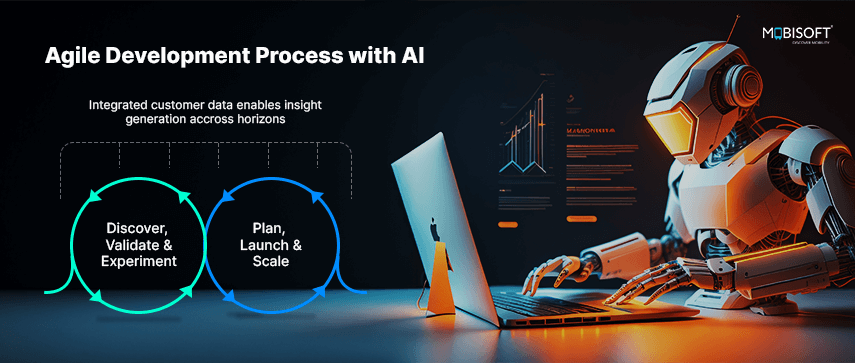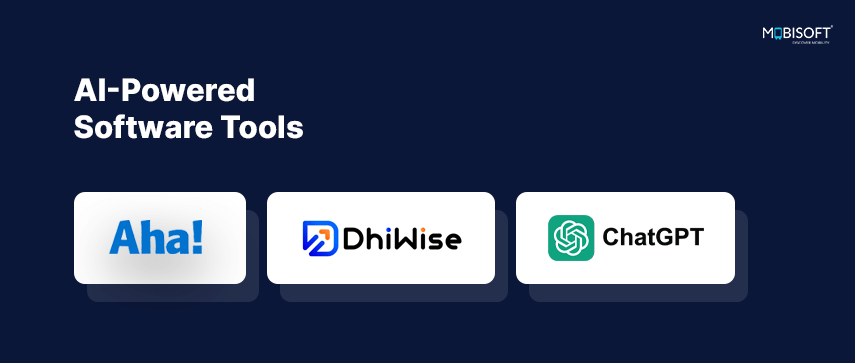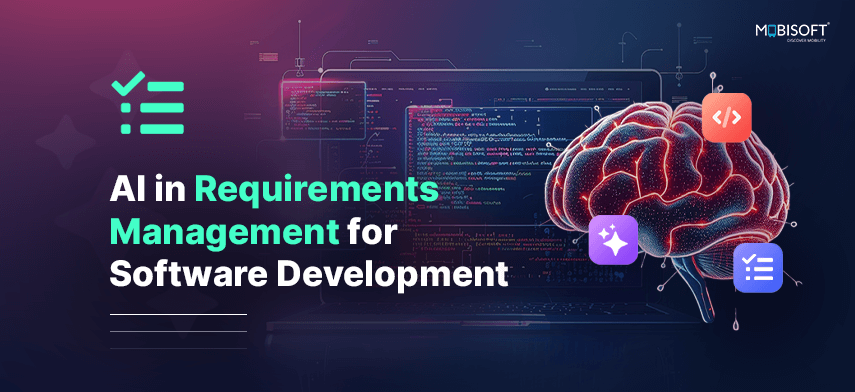In a competitive software development landscape, AI adoption is no longer just a trend—it's becoming an imperative. The Discovery phase—which includes drafting Statements of Work (SOWs), defining user stories, and designing UI guidelines—has long been a time-consuming and resource-draining process. With increasing pressure on AI-based software development teams to deliver high-quality results faster, AI-driven solutions are transforming how these processes are approached.
AI adoption in software development has the potential to reduce turnaround times, enhance productivity, and enable more accurate and collaborative workflows—all of which are crucial to improving software development timelines and client satisfaction. This blog explores how AI-driven tools are revolutionizing the Requirements Management process for both businesses and software development companies while offering real-world insights into the benefits of AI in software development and trending AI tools that are shaping the future of software development.

AI-Enabled Requirements Management: A Key to Accelerating Software Development
AI-enabled tools can now handle complex aspects of the Requirements Management software process, which historically required significant human intervention. From automating proposal drafting to creating detailed user stories and design guidelines, AI in project management empowers teams to streamline workflows, reduce manual effort, and maintain consistency across projects.
Here’s how AI in software engineering is changing the game:
Key Benefits of AI in Requirements Management:
- Optimized Performance: AI speeds up repetitive tasks like drafting SOWs and proposals. By reducing manual documentation efforts, teams can focus more on critical decision-making.
- Improved Accuracy: AI-driven solutions are adept at identifying gaps or inconsistencies in requirements management software, ensuring that business logic and client needs are met without error.
- Enhanced Synergy: AI fosters collaboration across departments, ensuring real-time updates, feedback loops, and enhanced communication, especially in cross-functional teams.

AI-Powered Solutions Boosting Efficiency in Requirements Management
1. Faster SOWs and Proposal Drafting for PreSales Teams
AI-powered solutions are a game-changer for PreSales teams. Instead of spending hours drafting SOWs and proposals, AI can generate these documents in minutes. AI-based requirements management software analyzes historical data, client preferences, and project templates to deliver personalized drafts, saving up to 50% of drafting time. This leads to quicker responses and a competitive edge for businesses seeking software development AI solutions.
2. Streamlining User Story and Functional Specification Drafting for Business Analysts (BAs)
For Business Analysts (BAs), drafting user stories and functional specifications is often one of the most time-consuming tasks in the requirements management phase. AI-driven software development tools can help by automatically generating user stories from initial business requirements, based on industry best practices. These AI tools can reduce the time spent on documentation by 60-70%, allowing BAs to spend more time analyzing and refining client needs.
3. Automating UI Design Guidelines for UI Designers
UI design is an integral part of the Discovery & Design phase, and UI designers often invest significant time in creating design guidelines and layout suggestions. With AI in software development, designers can receive instant design recommendations based on client requirements, ensuring consistency and accessibility. This helps UI designers save up to 40% of their time, allowing them to focus on user experience (UX) and finer design elements.
4. Improving Prioritization and Decision-Making for Product Managers
For Product Managers, AI solutions can help prioritize features and functionalities based on data insights, user feedback, and market trends. With AI-powered software development tools, product managers can automatically generate prioritized roadmaps and feature backlogs that better align with client objectives, ensuring faster decision-making and more accurate product development. By leveraging AI in software engineering to prioritize based on customer data, product managers reduce decision-making time by 30-40%.

AI Adoption: The Current Landscape
AI is no longer a futuristic concept; it is a present-day reality that is changing the way software development companies operate. From drafting proposals to generating user stories and creating UI designs, AI tools are streamlining processes and reducing time investment, making them indispensable in the requirements management phase.
Here are some eye-opening statistics that underscore the rapid pace of AI adoption in software development:
- 77% of software development companies have already integrated AI-driven solutions in at least one aspect of their workflow, and 75% of software executives see up to a 50% reduction in development time with increased AI and automation (Source: Outsystems.com).
- 42% of companies plan to adopt AI tools for requirements gathering and documentation in the next year, highlighting the rapid interest in AI-driven solutions for improving efficiency (Source: McKinsey & Company).
- 80% of Business Analysts report a 30-50% reduction in time spent drafting user stories and functional specifications, thanks to AI-powered automation tools (Source: arxiv.org).
These numbers underscore a clear trend: AI is not just a novelty but an essential part of modern software development practices. Companies that fail to adopt AI risk falling behind their competitors in terms of speed, quality, and cost efficiency.
AI adoption is accelerating in the software industry, with a significant portion of this growth happening within the Requirements Management and Discovery phases of software development.
A report from McKinsey & Company notes that AI adoption by organizations has increased from about 50% to 72% in recent years, with the use of GenAI growing from 33% to 65%, highlighting the growing integration of AI technologies across various industries (Source: McKinsey & Company).
AI-Enabled Product Development Life Cycle (PDLC): A Focus on Requirements Management (Discover & Validate)
The Product Development Life Cycle (PDLC) is the structured process of bringing a product from concept to completion, and integrating AI-powered tools throughout this cycle is increasingly becoming a game-changer for businesses. A key phase within the PDLC is Requirements Management, especially during the Discovery and Validation stages. Here, AI technologies streamline processes, improve efficiency, and ensure more accurate, data-driven decisions.
In the Discovery phase, AI in software engineering enables teams to gather and analyze requirements by automating data collection from multiple sources, such as customer feedback, market trends, and competitor analysis. AI-powered requirements builders and tools can quickly draft user stories, functional specifications, and even SOWs (Statements of Work), cutting down manual effort and reducing turnaround times by up to 50%.
During the validation stage, AI plays a crucial role in verifying and refining requirements. Using advanced analytics, AI tools can simulate scenarios and predict potential challenges, ensuring that requirements are realistic, aligned with user needs, and feasible within project constraints. This data-driven validation minimizes the risk of misunderstandings, scope creep, and costly rework later in the development cycle.
Insightful to know How an AI-enabled software product development life cycle will fuel innovation by McKinsey & Company
The Tangible Benefits of AI in Requirements Management
AI adoption brings a host of benefits to both businesses and software development companies. Here are the top advantages of incorporating AI-driven tools into the Requirements Management phase:
1. Enhanced Efficiency and Speed
AI can handle the time-consuming and repetitive tasks of document drafting, prioritization, and data analysis. By automating routine processes, AI frees up valuable time for teams to focus on high-level strategy and client collaboration.
AI tools have been shown to reduce project timelines by up to 30-50%, dramatically speeding up the entire discovery phase, and giving them a competitive advantage in the market.
2. Improved Accuracy and Consistency
AI tools help ensure that the requirements documentation is accurate and consistent across teams. With AI’s natural language processing (NLP) capabilities, it can flag inconsistencies or gaps in the requirements, preventing costly errors during software development in AI.
3. Enhanced Collaboration Among Stakeholders
AI tools foster collaboration among PreSales teams, BAs, UI designers, and product managers. With centralized platforms, real-time updates, and collaborative feedback loops, all stakeholders can stay aligned throughout the Requirements Management phase, leading to better decision-making and smoother project execution. This leads to smoother handoffs between teams, ensuring that the project remains on track and on time.
4. Security, Compliance, and Risk Mitigation
AI tools can help software development companies maintain security and compliance by automatically checking requirements against relevant standards, regulations, and guidelines. This not only reduces the risk of regulatory violations or legal complications down the line but also minimizes the chances of non-compliance and data breaches throughout the development process.
AI in Requirements Management: Keeping Humans at the Center
Despite the overwhelming benefits of AI, human expertise and decision-making remain essential throughout the requirements management phase. AI-driven solutions assist in generating drafts, detecting inconsistencies, and suggesting improvements, but humans are still needed to validate, refine, and make strategic decisions.
Why Human Input is Crucial:
- Contextual Accuracy: AI lacks the ability to interpret the broader business and market context in the way that humans do. While AI can suggest features, a human team member ensures that these align with client needs and market trends.
- Quality Control: AI can automate content generation, but final content validation requires human insight, especially for complex requirements.
Thus, AI-driven software development tools complement human capabilities—AI accelerates tasks, while humans provide the strategic insight and decision-making that AI cannot replicate.
AI Tools Shaping the Future of Requirements Management
Several AI-driven tools are gaining traction for their ability to transform the way software development teams work during the requirements management phase. These AI-based software development tools are specifically designed to streamline the process for various stakeholders in the development lifecycle:

DhiWise Requirements Builder is an AI-powered tool that helps PreSales reps create tailored SOWs and proposals in minutes, utilizing historical data and templates.
Link: DhiWise Requirements Builder
ChatGPTi assists in generating user stories and functional specifications based on minimal input from clients. It analyzes conversations and documents to create high-quality drafts making it a powerful assistant for BAs and PreSales teams.
Link: ChatGPT
Aha! Roadmaps provides AI tools integrated into Aha! assist product managers in prioritizing features based on client feedback, market data, and AI insights. Thus helping product managers align their product features with business goals and customer needs.
Link: Aha! Roadmaps
Conclusion: Embrace AI for Streamlined Requirements Management
AI adoption is no longer a luxury—it's a necessity. For businesses seeking software development companies, leveraging AI-enabled Requirements Management tools ensures that the discovery phase is completed faster, more accurately, and with better collaboration. For software development companies, adopting AI-powered solutions will help improve productivity, reduce costs, and ensure more agile project timelines.
The future of software development lies in AI-driven tools that accelerate the Requirements Management phase, increase efficiency, and ensure quality. By incorporating AI in software development, businesses can stay competitive and deliver high-quality software on time, while software development companies can enhance their offerings and provide more value to clients.
For businesses that embrace AI, the potential benefits are substantial: faster timelines, higher quality outputs, and cost reductions. However, it is crucial to remember that while AI accelerates workflows, human expertise is irreplaceable in ensuring that AI-generated outputs align with the client’s strategic goals.
With AI-driven tools already providing clear value across various teams, now is the time for software development companies to embrace AI adoption and position themselves at the forefront of innovation. The future of software development is AI-powered, and the time to adopt is now.





 February 20, 2025
February 20, 2025


